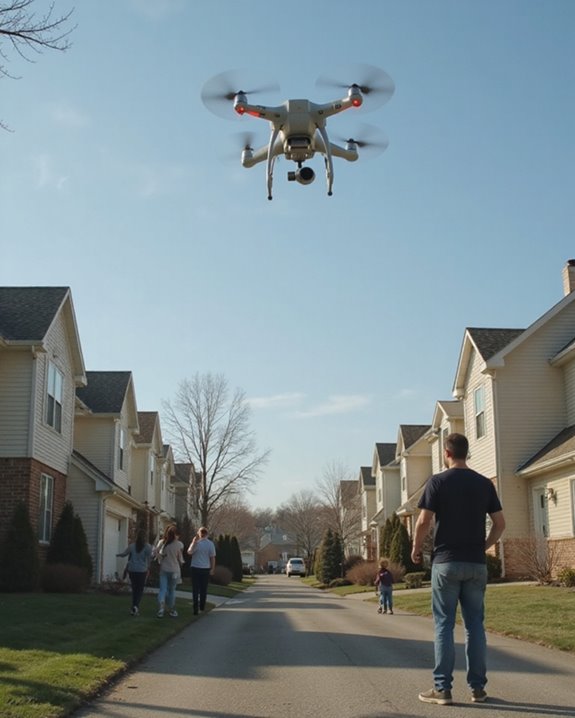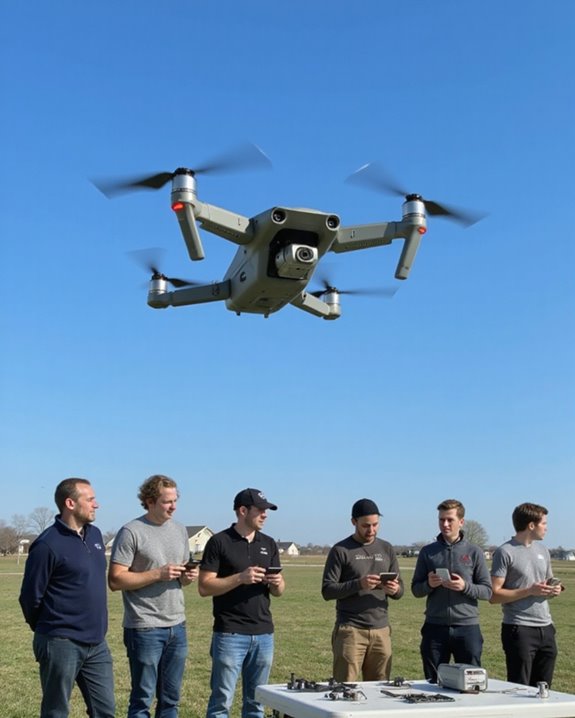Car-sized drones are shaking up industries everywhere, tackling jobs from zipping over fields to spray crops with surgical precision to hauling steel beams at construction sites, even delivering urgent medical supplies during disasters! These giants in the sky can scan bridges for cracks, track wildlife at night, and broadcast live concerts with cinema-worthy footage. Imagine a farm robot, search-and-rescue hero, and movie cameraman—all rolled into one high-flying package. Ready to uncover just how futuristic these flying machines are?
Key Takeaways
- Car-sized drones revolutionize agriculture by enabling precise, large-scale crop spraying, yield monitoring, and targeted pest control with advanced sensors and AI analytics.
- In logistics, these drones deliver heavy payloads quickly, reduce fuel use, and bypass urban traffic, transforming supply chains and emergency relief efforts.
- They provide critical support in disaster response by delivering medical supplies, mapping damage, and locating survivors using thermal imaging and real-time data.
- Infrastructure inspection and environmental monitoring benefit from car-sized drones’ ability to detect hazards, survey habitats, and monitor pollution with high-resolution cameras and LiDAR.
- Film and media industries use these drones for high-quality aerial imagery, live event coverage, and dynamic shots previously only possible with helicopters.
Agricultural Spraying and Crop Management
Imagine a machine the size of a small car, hovering over fields and spraying crops with pinpoint accuracy—that’s the power of today’s agricultural drones! These giants, equipped with tanks as large as 72 liters, bring Efficiency Optimization to a new level. They can cover up to 60 acres an hour, talk about a speedy farmhand! Thanks to sensors that monitor liquid levels and GPS-guided navigation, drones deliver Targeted Application of pesticides or fertilizers, reducing waste and protecting the environment. Forget about blanket spraying—these flying farmers treat only the plants that need it. With refill times under a minute and per-acre costs dropping below $15, it’s hard not to be impressed. Even the crops seem to be cheering for these high-tech helpers! Their operation is further enhanced by GPS/GLONASS systems that support precise spraying patterns and automatic return features, ensuring reliable and efficient coverage.
Nighttime Crop Monitoring and Livestock Tracking

After sunset, when most folks are winding down, the real magic begins out on the farm—thanks to car-sized drones built for nighttime crop monitoring and livestock tracking. With sharp thermal sensors and night vision cameras, these drones glide above fields, spotting plant health issues or wandering cows, all while you’re cozy indoors. Imagine a “flying farmhand” that never sleeps! Real-time tracking guarantees livestock welfare, as drones catch signs of stress or illness in animals before bigger problems develop. For crops, advanced sensors detect growth patterns, water needs, or sneaky pests under the cover of darkness. All the data zips back to farmers, helping them make smart choices fast. Plus, drones use less fuel and make less noise than tractors—bonus points for being eco-friendly! Many models now incorporate omnidirectional obstacle sensing to safely navigate complex agricultural environments even in low light.
Rapid Logistics and Long-Range Delivery
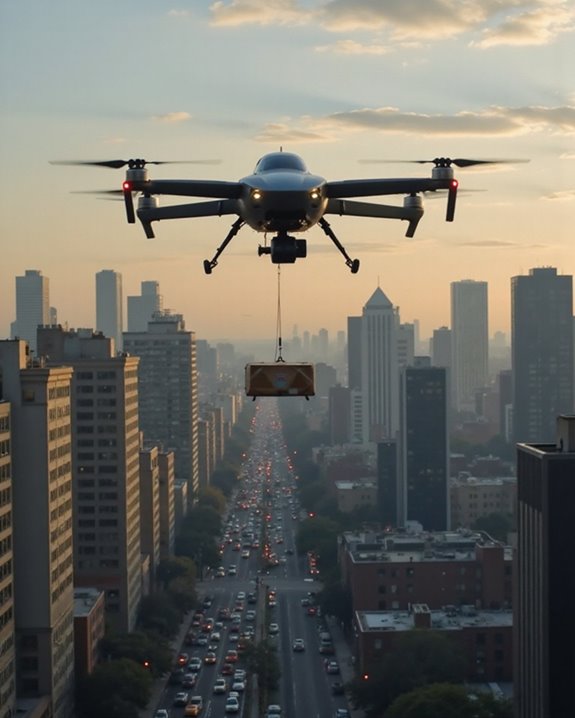
A new era in delivery is taking flight, and car-sized drones are at the heart of it! Imagine packages zooming through the sky, dodging traffic jams—thanks to Speed Enhancements and Range Extensions, it’s no longer science fiction. The drone logistics market could soar to $275.8 billion by 2037, as companies like Walmart jump on board and regulations adapt. Drones bring ultra-fast, long-range delivery, conquering tough terrains and saving up to 47 gallons of fuel for every 20% of diesel deliveries replaced. Advances in AI, batteries, and sensor tech mean bigger payloads and sharper navigation. With 79% of consumers favoring drone delivery, even your grandma might soon marvel at her medicine flying in! Supply chains, meet your new MVP. Additionally, innovations such as drones weighing under 250 grams help streamline regulations by eliminating the need for FAA registration.
Enhancing Urban Delivery Networks
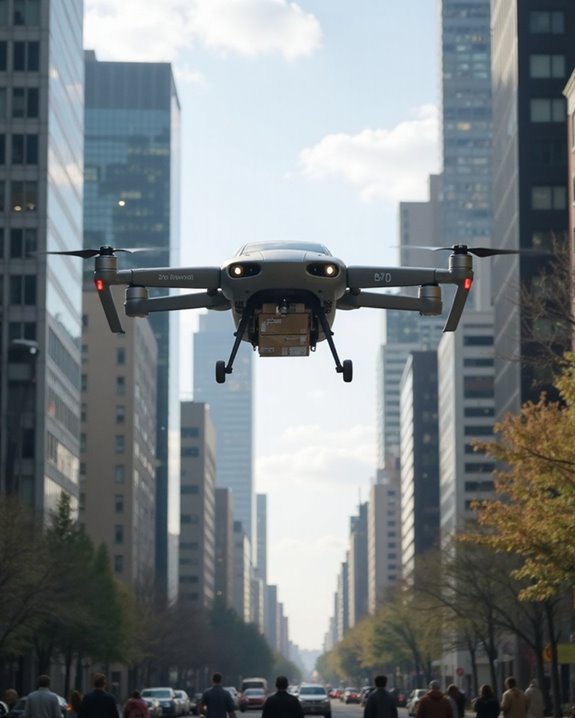
When it comes to city life, speed and convenience rule the day—especially when you’re waiting for your online order! Car-sized drones are shaking up urban delivery networks, flying right over traffic jams and parking headaches, landing your package almost at your doorstep. Delivery innovation is at the heart of this change, with drones slashing delivery times and making life a little easier for busy city dwellers. Urban security matters, too—advanced navigation and collision-avoidance tech keep these flying couriers safe above crowded streets. Sure, it’s not all smooth sailing; finding the perfect rooftop landing pad can be tricky, and regulations are strict for good reason. Still, drones are greener, quieter, and more cost-effective than trucks, making them the superhero of tomorrow’s urban logistics!
Heavy-Lift Construction and Material Transport
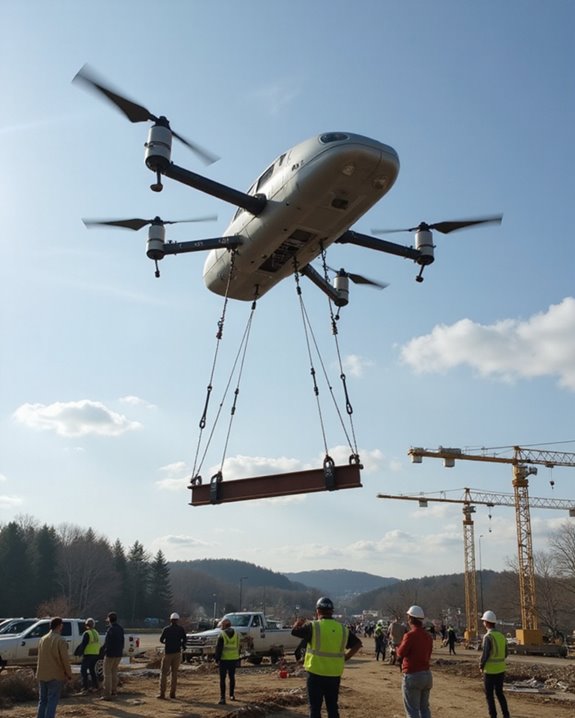
Imagine seeing a massive drone swoop in, gently lowering a bundle of steel beams onto a construction site—no crane in sight! That’s the power of construction automation, and it’s changing how building projects get done. Heavy-lift drones boost payload efficiency, carrying everything from timber and concrete to masonry, even when the delivery spot is tricky to reach. These flying giants eliminate the need for traditional cranes, making worksites safer and more cost-effective. With advanced stabilization and precision landing, they place materials exactly where needed—no more “just a little to the left!” moments. Market forecasts show huge growth ahead, with the global heavy-lift drone market expected to reach $1.4 billion by 2030. That’s a lot of steel beams in the sky!
Infrastructure Inspection and Maintenance
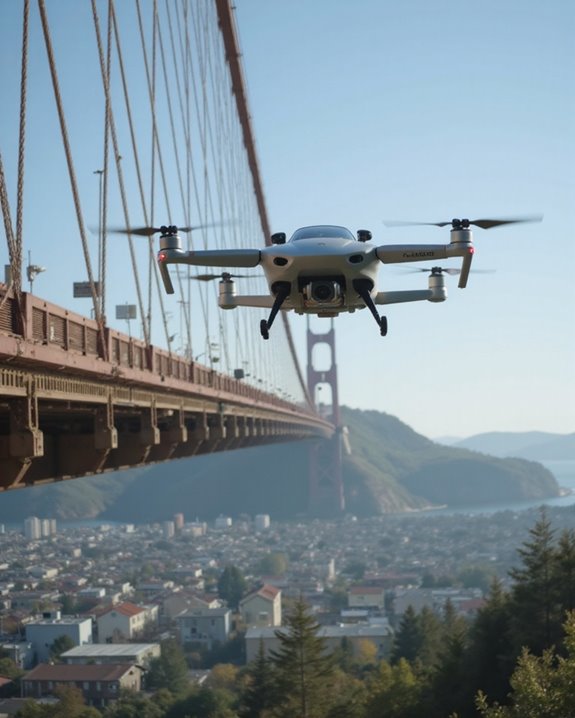
Ever wondered how giant bridges, endless pipelines, or those dizzyingly tall wind turbines get checked for safety without sending people scrambling up ladders or shutting down traffic? Car-sized drones have made infrastructure inspection and maintenance a breeze! These flying giants use high-resolution cameras, LiDAR, and thermal imaging for detailed Structural Analysis and Hazard Detection—no binoculars or hard hats required. They spot hairline cracks in steel, hidden corrosion, or overheated electrical lines from the air, delivering real-time data to engineers. Drones can glide over busy highways, soar up wind turbine blades, and hover beside offshore platforms, all without causing a single traffic jam. They save time, money, and, let’s be honest, a lot of sweaty palms. Who knew safety could be so high-tech and efficient?
Search and Rescue Operations
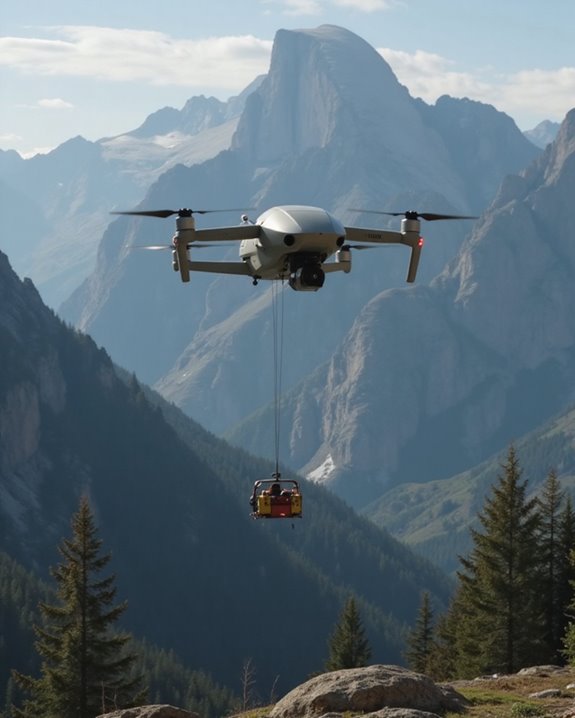
While car-sized drones are already shaking up the world of bridge and turbine checkups, their real superhero moment comes during search and rescue operations. Imagine a drone, about the size of your family sedan, zipping over a rocky coastline or hovering above a snowy mountain—pretty cool, right? These giants cover vast areas quickly, making Coastal Searches and Mountain Rescues faster and safer. With live video feeds, rescuers can spot lost hikers or stranded boaters in real-time, all while staying out of harm’s way. Their powerful cameras and thermal sensors pick up heat signatures, even at night or in fog. Car-sized drones also carry extra gear, work longer without stopping, and talk to command centers instantly, making every minute count in a crisis!
Disaster Response and Emergency Supply
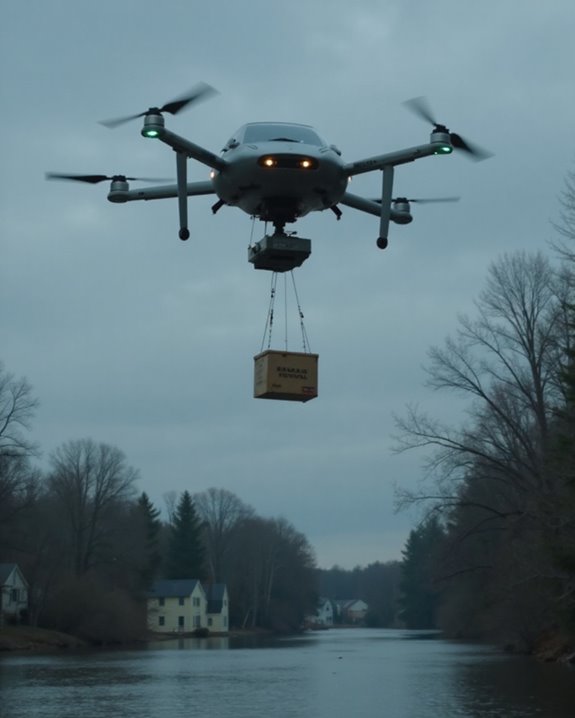
Although natural disasters can strike in the blink of an eye, car-sized drones are proving to be a real game-changer when it comes to emergency response and supply delivery. Imagine a giant drone swooping in for Flood Relief, carrying medicine, food, or even clean water to people stranded by rising waters! In Earthquake Aid scenarios, these drones can zip past rubble and blocked roads, delivering essentials where trucks simply can’t go. They map damage, provide real-time video feeds, and help responders see exactly where help is needed most—no capes required! Semi-autonomous technology, like obstacle avoidance and real-time data analysis, keeps costs down and efficiency high. From Cyclone Idai in Mozambique to the Beirut port blast, drones are making disaster relief smarter, faster, and safer.
Environmental Monitoring and Wildlife Conservation

From dropping emergency supplies in a flood to zipping over earthquake rubble, car-sized drones have already shown they can save the day—now picture them becoming superheroes for the planet itself! These airborne giants are changing the game in Environmental Monitoring and Wildlife Conservation. With Emission Detection sensors, drones can fly over factories, sniffing out pollutants like a bloodhound on a mission, and catch environmental violations in real time. Their high-resolution imaging allows for incredibly detailed Habitat Mapping, tracking animal movements, plant health, and even poaching activities without disturbing a single leaf. By combining drone data with satellite maps and machine learning, scientists can spot changes in habitats, identify pollution hotspots, and protect endangered species faster than ever. Who knew saving the planet could look this cool?
Aerial Cinematography and Event Production
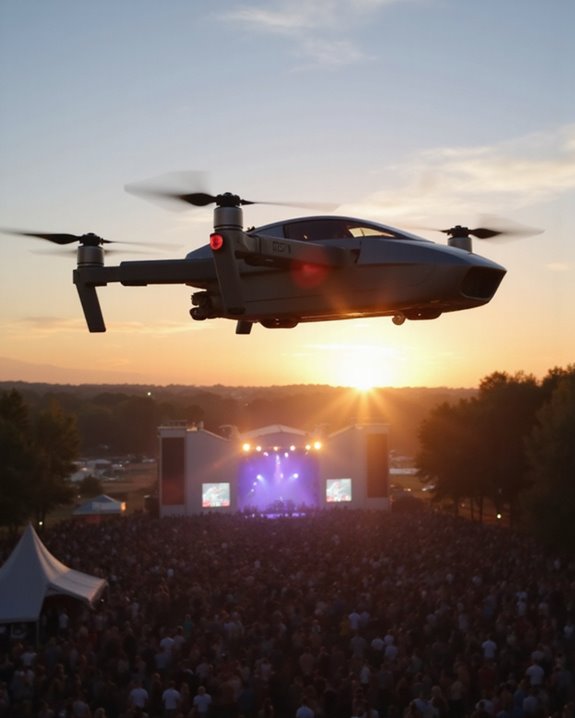
Ever wonder how filmmakers get those jaw-dropping shots soaring over city skylines or weaving through packed stadiums? Car-sized drones are the secret behind those cinematic marvels, providing dynamic aerial perspectives for blockbuster movies, music festivals, and even the Olympic Games! Thanks to high-resolution cameras—think 32 MP and above—viewers enjoy crystal-clear visuals during Live Streaming and Virtual Events, making it feel like you’re right in the action. These drones can carry heavy equipment, stay airborne for hours, and capture angles no helicopter could dream of. Plus, they’re safer and more budget-friendly than traditional camera rigs. Whether it’s streaming a concert live or producing a virtual sports event, these flying giants are revolutionizing how people see and experience big moments on screen!
Frequently Asked Questions
What Are the Regulatory Challenges for Operating Car-Sized Drones in Public Airspace?
Regulatory challenges for operating car-sized drones in public airspace include managing international regulations, resolving airspace conflicts with manned aircraft, meeting strict certification requirements, securing operational waivers, and addressing safety, privacy, and security concerns within evolving national and global frameworks.
How Much Does a Typical Car-Sized Drone Cost to Purchase and Maintain Annually?
A typical car-sized drone’s cost breakdown includes a purchase price ranging from $50,000 to over $400,000, with annual maintenance at 10%-20% of that sum. Funding options may include leasing, loans, or business investment.
What Types of Training or Certification Do Operators of Car-Sized Drones Require?
Operators of car-sized drones must complete specific certification pathways, including FAA Part 107 requirements and recurrent training. Training simulations enhance airspace awareness, weather assessment, risk management, and emergency procedures, ensuring proficiency and compliance with regulatory, safety, and operational standards.
How Are Privacy and Data Security Concerns Addressed With Large Drones?
Privacy and data security concerns are addressed through measures such as DataEncryption, strict UserPrivacy protocols, geo-fencing, anonymization technologies, limited data collection, and access controls, with regulatory compliance ensuring responsible data handling and ongoing development of protection standards.
What Is the Average Lifespan and Maintenance Schedule for a Car-Sized Drone?
The average lifespan of a car-sized drone ranges from several hundred to thousands of flight hours, determined largely by engine durability. Strict inspection routines, regular component replacement, and consistent maintenance schedules are essential to maximize operational longevity and efficiency.


